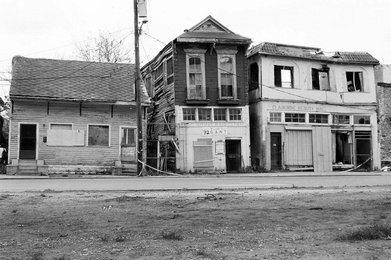When Christina Molieri started graduate school in fall 2006 in a dual-master’s program, she found she had little time to exercise her passion for community activism. However, as spring break approached, instead of planning a relaxing vacation, Molieri began packing her bags for New Orleans, to help rebuild one of the areas that was hardest hit by Hurricane Katrina.
Molieri’s March 2007 trip generated several rolls of film that she hopes will convey the true impact of the storm and its aftermath — on display at the William Way LGBT Community Center, 1315 Spruce St., from Sept. 6-Oct. 31.
Molieri, the center’s former program coordinator, was in the process of attaining her master’s in social service and law and social policy from Bryn Mawr College when the idea for the trip arose.
Molieri said her friends living in New Orleans related the widespread devastation and “the blind injustices that occurred when the hurricane hit and that continued to occur with how it was handled.”
She connected with Common Ground, a nonprofit relief group formed after the hurricane, and got a flight to New Orleans for just $100. Although she didn’t intend for the trip to result in an exhibit, she packed her camera and some film to capture the experience.
Molieri has a degree in journalism from Temple University and said she’s always had an interest in photography and the social possibilities it affords.
“Photography for me has always been about looking at the relationships between documentation of social reality and the movement for social change,” she said.
Molieri found that once she arrived in Louisiana, there was plenty to document.
She spent nearly two weeks living with other Common Ground volunteers at St. Mary of the Angels School in the Upper 9th Ward.
The volunteers focused on residential houses that were severely damaged by the storm, ripping up carpets, removing drop-ceilings and gutting them to the studs to prepare them for rebuilding.
Even though Katrina claimed the homes and loved ones of many of the area’s residents, Molieri said the spirit emanating from both the locals and the volunteers was overwhelming.
“I got such an enormous sense of strength and solidarity from the community. People had been dealing with this since day one and they were just trying to survive. They’d lost everything but they didn’t lose their sense of compassion.”
As she was working, Molieri captured shots of the rebuilding efforts and the widespread destruction in the Lower 9th Ward.
Even though she arrived in New Orleans more than a year-and-a-half after Katrina hit, she said the impact of the storm was evident from her first day.
“I was in the airport shuttle to St. Mary’s and I was in with some folks who were going to the Four Seasons and the Marriott, and they were talking about, ‘Oh, this isn’t so bad. I don’t know why everyone’s making such a big deal.’ And the driver knew where I was going, so he didn’t say anything,” she said. “After we dropped them off, we were at Congress Avenue, and it’s this long street that divides a big chunk of the city and once you cross it, we were in the Lower 9th Ward. When we crossed that street, it was literally like going into Beirut. The houses were burnt down, and there were a lot of houses that still hadn’t been touched. There was furniture piled everywhere, and you could see the water lines and the spray paint on the doors telling you how many bodies had been found.”
Molieri noted that the tourists with whom she shared the shuttle illustrated that, once news crews left New Orleans, national attention shifted elsewhere.
The disparity between the reality of New Orleans and the public perception was one of the main motivating factors for Molieri’s photo exhibit.
“I hesitated about showing it for a long time because I didn’t want it to come across as self-serving. I want this to be about what is and isn’t happening and what still remains to be done, even now, five years later. Without documentation like this, it just doesn’t exist. I want people to think, to hopefully feel some resonance with these images. I’m not showing anything foul or offensive at all, but I’m hoping the photos actually make people’s skin crawl a little bit, because that’s what I felt when I saw it. I want people to almost be able to smell the mold that hit me and that encircled the entire city. This is too important an event in our history to just forget and let it pass too easily.”
A reception for “The Lower Nine: A Post-Katrina Odyssey” will be held 6-8 p.m. Sept. 10 at the center, during which Molieri will discuss her experiences in New Orleans. For more information, call (215) 732-2220.
Jen Colletta can be reached at [email protected].
